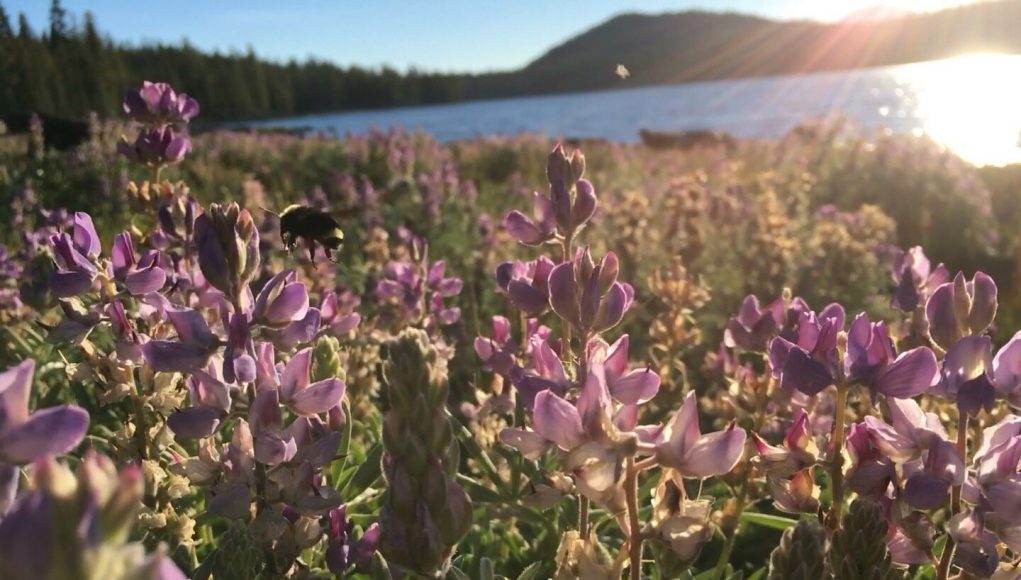Many species of North American bumble bees have seen significant declines in recent decades. Bumble bees are essential pollinators for both native and agricultural plants, and their ability to fly in colder temperatures make them especially important pollinators at high elevation. Bumble bee declines have been attributed to a handful of factors, including lack of flowers. Not all flowers are used equally by bumble bees, and determining which flowers bumble bees use can aid bumble bee conservation by identifying the specific plants they need to thrive.
New research published in the journal Environmental Entomology examines which flowers bumble bees select in the Sierra Nevada region of California. Researchers from The Institute for Bird Populations, the University of Connecticut, and the USDA Forest Service compared which species of flowers the bees used relative to the availability of each flower species across the landscape. They found that each bumble bee species in the study selected a different assortment of flowers, even though the bees were foraging across the same landscape. This information can be useful to land managers who are restoring or managing meadows and other riparian habitat for native bumble bees.
This study of bumble bee floral use was unusual because it factored in the relative availability of each plant species to the bees. “It’s important to consider the availability of plants when determining what’s selected for by bees,” says Jerry Cole, a biologist with The Institute for Bird Populations and lead author of the study. “Often studies will use the proportion of captures on a plant species alone to determine which plants are most important to bees. Without comparison to how available those plants are, you might think a plant is preferentially selected by bees, when it is simply very abundant.”
The researchers captured, identified, and released bumble bees at over 400 sample plots in the Plumas National Forest. They recorded which flower each bee was captured on and estimated the availability of flowers in the plot. Though they captured bumble bees on over 100 different species of flower, only 14 of these plant species were preferentially selected by any of the bumble bee species. Thirteen species of bumble bees were captured; among the five most common species, each selected a different assortment of flowers, and each selected at least one flower species that was not selected by the other bumble bee species.
In addition, the study found some previously undocumented bumble bee-plant associations; for instance, Bombus bifarius (sometimes known as the two-form bumble bee) preferentially selected thickstem aster flowers Eurybia integrifolia, while the black tail bumble bee (Bombus melanopygus) preferentially selected Rydberg’s penstemon flowers (Penstemon rydbergii). They also found that bees use different species of flowers at different times in the summer, as early blooming flowers are replaced by late-blooming flowers.
Find your dream job in the space industry. Check our Space Job Board »
“We discovered plants that were big winners for all bumble bee species but, just as importantly, plant species that were very important for only a single bumble bee species,” says Helen Loffland, a meadow species specialist with The Institute for Bird Populations. “This study allowed us to provide a concise, scientifically based list of important plant species to use in habitat restoration that will meet the needs of multiple bumble bee species and provide blooms across the entire annual lifecycle.”
The USDA Forest service has already put the study’s results to use. “Restoration planning on the Plumas National Forest is already using these results to identify areas where restoration efforts may increase availability or improve quality of bumble bee habitat,” says co-author Matthew Johnson, who is the Wildlife, Fish, Rare Plants and Invasive Species Program Manager at the Plumas National Forest. In addition, Forest Service personnel have collected seed from plants favored by bumble bees and are experimenting with the best way to use in them in seed mixes. Johnson says he also hopes to work with students at Greenville High School in Greenville, California, and Feather River College in Quincy, California, to propagate bumble bee-friendly plants for use in restoration.
A better understanding of bumble bees’ flower preferences will aid in conservation of declining bee species. “This sort of knowledge can really increase the effectiveness of restoration for bumble bees,” says Loffland, “and in a way that is relatively easy and cost-effective to implement.”
Provided by: Entomological Society of America
More information: Jerry S Cole et al. Plant Selection by Bumble Bees (Hymenoptera: Apidae) in Montane Riparian Habitat of California. Environmental Entomology (2019). DOI: 10.1093/ee/nvz159
Image: A Vosnesensky bumble bee (Bombus vosnesenskii) flies in a field of lupine flowers.
Credit: Spencer Hardy, The Institute for Bird Populations











